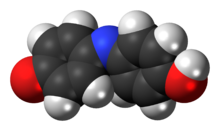Indophenol

| |

| |

| |
| Names | |
|---|---|
| IUPAC name
4-(4-hydroxyphenyl)iminocyclohexa-2,5-dien-1-one
| |
| Other names
Benzenoneindophenol, phenolindophenol[1]
| |
| Identifiers | |
3D model (JSmol)
|
|
| ChemSpider | |
| ECHA InfoCard | 100.007.194 |
PubChem CID
|
|
| UNII | |
CompTox Dashboard (EPA)
|
|
| |
| |
| Properties | |
| C12H9NO2 | |
| Molar mass | 199.209 g·mol−1 |
| Appearance | Reddish-blue powder[1] |
| Melting point | above 300 °C[1] |
Except where otherwise noted, data are given for materials in their standard state (at 25 °C [77 °F], 100 kPa).
| |
Indophenol is an organic compound with the formula OC6H4NC6H4OH. It is deep blue dye that is the product of the Berthelot's reaction, a common test for ammonia.[2] The indophenol group, with various substituents in place of OH and various ring substitutions, is found in many dyes used in hair coloring and textiles.[3]
Indophenol is used in hair dyes, lubricants, redox materials, liquid crystal displays, fuel cells and chemical-mechanical polishing. It is an environmental pollutant and is toxic to fish.[1][4]
Berthelot test
[edit]In the Berthelot test (1859), a sample suspected of containing ammonia is treated with sodium hypochlorite and phenol. The formation of indophenol is used to determine ammonia and paracetamol by spectrophotometry.[5] Other phenols can be used. Dichlorophenol-indophenol (DCPIP), a form of indophenol, is often used to determine the presence of vitamin C (ascorbic acid).[6]
Related compounds
[edit]Indophenol blue is a different compound with systematic name N-(p-dimethylaminophenyl)-1,4-naphthoquinoneimine.[7]

References
[edit]- ^ a b c d Sabnis, R. W. (2007). Handbook of Acid-Base Indicators. CRC Press. p. 196. ISBN 978-0-8493-8219-2.
- ^ Patton, Charles J.; Crouch, S. R. (1977). "Spectrophotometric and kinetics investigation of the Berthelot reaction for the determination of ammonia". Analytical Chemistry. 49 (3): 464–469. doi:10.1021/ac50011a034.
- ^ Horst Berneth (2002). "Azine Dyes". Ullmann's Encyclopedia of Industrial Chemistry. Weinheim: Wiley-VCH. doi:10.1002/14356007.a03_213.pub2. ISBN 978-3527306732.
- ^ "Indophenol I5763". 500-85-6. Retrieved 2020-06-11.
- ^ Tsuboi, T.; Hirano, Y.; Shibata, Y.; Motomizu, S. (2002). "Sensitivity improvement of ammonia determination based on flow-injection indophenol spectrophotometry with manganese(II) ion as a catalyst and analysis of exhaust gas of thermal power plant". Analytical Sciences. 18 (10): 1141–4. PMID 12400662.
- ^ Hughes, David Emlyn (1983). "Titrimetric Determination of Ascorbic Acid with 2,6-Dichlorophenol Indophenol in Commercial Liquid Diets". Journal of Pharmaceutical Sciences. 72 (2): 126–129. doi:10.1002/jps.2600720208.
- ^ Graham, S. O. (1963). "Indophenol Blue as a Chromogenic Agent for Identification of Halogenated Aromatic Hydrocarbons". Science. 139 (3557): 835–836. Bibcode:1963Sci...139..835G. doi:10.1126/science.139.3557.835.
